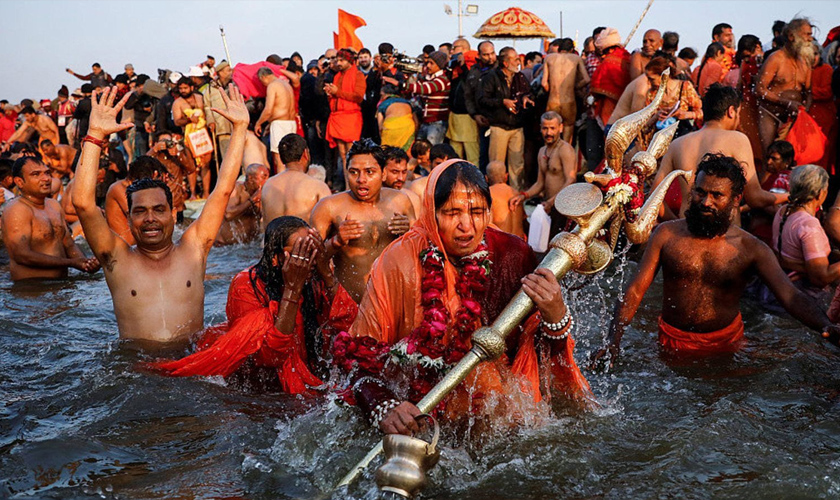The Kumbh Mela is one of the most extraordinary religious gatherings in the World. It is a testament to India’s rich cultural diversity and spiritual heritage. Rooted in ancient traditions, this colossal festival attracts millions of pilgrims from across the globe. Do you know Why Kumbh Mela is Celebrated? In this comprehensive guide, we will talk about the Kumbh Mela, exploring its origins, significance, rituals, and practical aspects to provide potential attendees with a deeper understanding of this awe-inspiring event.
Maha Kumbh Mela
One of the most important religious events in India is the Kumbh Mela, sometimes referred to as the Kumbha Mela. Kumbh Mela is held after every 12 years. The Maha Kumbh Mela, which takes place every 144 years, is regarded as the most important Kumbh Mela. The most recent Maha Kumbh Mela took place in Allahabad in 2013.
The festival is a gathering of millions of devotees who come to take a holy dip in the sacred rivers of India, and it is considered to be the largest peaceful gathering of people in the world. The event is the greatest peaceful assembly of people in the world, drawing millions of devotees who come to take a spiritual bath in one of India’s revered rivers. Over antiquity, the celebration evolved into a chance for people to bathe in sacred rivers and ask the gods and goddesses for favours.
History of Kumbh Mela
Indian culture has a long history and is firmly anchored in the Kumbh Mela. The event is supposed to have started during the Vedic era when Hindu ascetics and sages congregated to share information and talk about spiritual issues.
The Kumbh Mela finds its roots in Hindu mythology, tracing back to the churning of the cosmic ocean (Samudra Manthan). According to legend, a pot (kumbh) containing the nectar of immortality emerged from the churning, leading to a celestial struggle for its possession. Drops of this nectar fell at four locations on Earth. These places are Prayagraj, Haridwar, Nashik, and Ujjain, where the Kumbh Mela is celebrated cyclically.
The Kumbh Mela was first documented in writing in the seventh century, under King Harsha. The Kumbh Mela changed throughout time from a modest gathering of saints and sadhus to a vast fair. The Kumbh Mela draws millions of visitors from across the world. With the establishment of infrastructure and services for pilgrims, the British colonial administration significantly contributed to moulding the Kumbh Mela into its modern form.
The Significance of Kumbh Mela
The significance of the Kumbh Mela lies in the belief that bathing in the holy rivers during specific astrological configurations can cleanse one of the sins and bestow spiritual enlightenment. The festival serves as a confluence of spiritual energies, with sadhus, saints, and seekers gathering to share knowledge, engage in religious discourse, and participate in rituals.
Kumbh Mela is a significant cultural event that highlights India’s beautiful diversity. It promotes social harmony and brings together people from all walks of life.
For Indians, the Kumbh Mela is of utmost religious, spiritual, and social importance. The celebration is thought to cleanse one’s sins and aid in salvation.
Taking a bath in one of India’s holy rivers during the Kumbh Mela is regarded as a means of obtaining eternal life because it is believed that these rivers are endowed with the nectar of immortality.
During the Kumbh Mela, it is said that bathing in the sacred river cleanses the soul and washes away sins. Devotees use the occasion to undertake rituals and rites, as well as to ask for the blessings of holy men and women.
The Kumbh Mela provides worshippers and spiritual seekers with a chance to connect with the divine and pursue enlightenment. The festival offers a venue for attendees to interact with spiritual leaders, take part in discussions, and develop their spiritual practices.
Kumbh Mela is important from a sociological standpoint as well. It fosters harmony and unification by bringing together people from many nations, beliefs, and backgrounds. It provides a chance for people to honour their ancestry and culture while fostering a sense of community and belonging.
Kumbh Mela Places in India
Kumbh Mela is observed at four Places in India. Allahabad (now Prayagraj), Haridwar, Nashik, and Ujjain, among other places in India.
In India, the Kumbh Mela is observed in four different cities, each with its special importance.
When Jupiter is in Aries, Prayagraj hosts the Mela;
when Jupiter is in Aquarius, Haridwar hosts the Mela;
when Jupiter is in Leo, Nashik hosts the Mela; and
when Jupiter is in Scorpio, Ujjain hosts the Mela.
Kumbh Mela Rituals and Ceremonies
Shahi Snan (Royal Bath):

The highlight of the Kumbh Mela is the Shahi Snan, or the Royal Bath, which takes place on auspicious dates. The main bathing dates are determined by a complex astrological calculation and attract the largest crowds. Witnessing the various akharas (religious sects) of sadhus leading the processions to the riverbanks is a mesmerizing spectacle.
The Shahi Snan, also known as the Royal Bath, is the most important Kumbh Mela rite. It is the holy bath worshippers and sadhus take in the revered rivers. The Shahi Snan occurs on auspicious days and hours that are chosen based on the Hindu calendar.
The Kumbh Mela offers several riverbanks or bathing ghats where attendees can cool off. Each ghat has a special meaning, and worshippers pick the one that speaks to them the loudest.
Other rites and practices take place at the Kumbh Mela in addition to the Shahi Snan. These consist of sermons, cultural performances, and humanitarian endeavours.
Akharas and Sadhus:
The Kumbh Mela is a unique opportunity to witness the diverse sects of sadhus, each with its distinct practices and philosophies. The akharas, akin to spiritual orders, showcase a kaleidoscope of rituals and ceremonies. Interacting with sadhus can offer profound insights into their way of life and spiritual teachings.
Also Read: Interesting Facts About Naga Sadhu
Cultural Performances:
Beyond the spiritual fervour, the Kumbh Mela is a celebration of India’s cultural diversity. Attendees can immerse themselves in classical music and dance performances, folk art exhibitions, and cultural programs that showcase the vibrant heritage of the country.
Planning Your Visit to Kumbh Mela
Accommodation:
Given the massive influx of pilgrims, securing accommodation well in advance is crucial. Options range from makeshift tents to more comfortable lodgings. Prayagraj, Haridwar, Nashik, and Ujjain have a variety of accommodations to suit different preferences and budgets.
Travel Logistics:
Plan your travel to align with the key bathing dates. The influx of millions can create logistical challenges, so arriving a few days before the main events can provide a more manageable experience. Public transportation, including special trains and buses, is often organized for the convenience of attendees.
Essential Items:
As the Kumbh Mela involves spending considerable time outdoors, packing essentials such as comfortable clothing, sunscreen, a hat, and sturdy footwear is crucial. Carrying a water bottle and some light snacks is advisable, given the crowds and the vastness of the festival grounds.
Health and Safety:
The Kumbh Mela is a physically demanding event, and attendees should prioritize their well-being. Adequate hydration, caution against waterborne diseases, and following basic hygiene practices are essential. Medical facilities are typically set up, but carrying a basic first aid kit is advisable.
Etiquette and Cultural Sensitivity
Respect Local Customs:
The Kumbh Mela is deeply rooted in tradition, and attendees should respect the local customs and practices. Seek permission before photographing sadhus or participating in rituals, and be mindful of the spiritual significance attached to certain activities.
Environmental Responsibility:
With millions of people converging in one place, environmental concerns are significant. Dispose of waste responsibly, avoid littering, and contribute to the overall cleanliness of the festival grounds. Being environmentally conscious aligns with the spiritual ethos of the Kumbh Mela.
The Kumbh Mela Experience
Kumbh Mela’s attendance is a once-in-a-lifetime opportunity. It necessitates meticulous planning, preparation, and a readiness to accept the chaos and masses. Pilgrims must register with the local government and get a special pass to participate in the Kumbh Mela. Additionally, they need to plan their transportation, lodging, and meals.
Pilgrims engage in rituals like bathing in the sacred river, listening to sermons and lectures by holy men and women, doing puja, and other ceremonies during the Kumbh Mela. They also go to the numerous camps established by various sects and groups where they can ask for blessings, get prasad, and take part in cultural activities.
Also Check: 35 Fairs and Festivals of Rajasthan
Conclusion
India’s rich cultural and religious diversity is celebrated at the Kumbh Mela. The Kumbh Mela is not only a religious gathering; it is a spiritual journey, a cultural extravaganza, and an exploration of India’s profound heritage. Millions of people gather on this occasion to seek social harmony and spiritual development. For those seeking a transformative experience, attending the Kumbh Mela is an opportunity to witness the convergence of faith, tradition, and the sheer diversity that defines the soul of India. By understanding the significance, rituals, and practical aspects, attendees can embark on this spiritual odyssey well-prepared, ensuring a meaningful and enriching experience at the Kumbh Mela.
FAQs
Q 1. Why is Kumbh Mela celebrated?
A. Kumbh Mela is celebrated to honour Hindu mythology’s churning of the ocean for the elixir of immortality. Pilgrims gather at sacred rivers in India for ritualistic bathing, seeking spiritual purification and blessings from the divine during this massive religious festival.
Q.2 Why Kumbh Mela is celebrated after 12 years?
A. Kumbh Mela is celebrated every 12 years based on Hindu mythology, marking the time it took for gods and demons to churn the ocean for the nectar of immortality. The twelve-year cycle symbolizes the cosmic rhythm and renewal of spiritual energy.
Also Check



